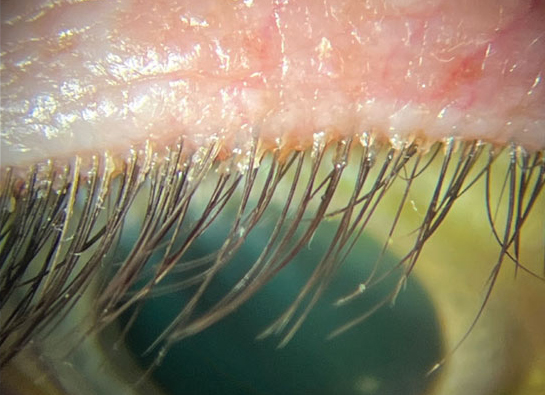 |
| In this study, Demodex patients younger than 40 had lower meibum quality compared with those without Demodex, and patients between 40 and 60 had higher OSDI scores and MG expressibility.. For patients over 60, no correlation was found between dry eye metrics and Demodex infestation. Photo: Cecelia Koetting, OD. Click image to enlarge. |
Patients with ocular Demodex infestation often present with ocular surface issues such as dry eye or meibomian gland dysfunction (MGD). Given that higher Demodex prevalence and more severe MGD have both been observed among the geriatric population, researchers recently investigated whether age has an influence on dry eye disease (DED) and MGD signs and symptoms in Demodex patients. They found that ocular demodicosis patients younger than 40 had significantly lower meibum quality grades than those without the condition; however, interestingly, in patients over 60, Demodex infestation didn’t appear to affect signs or symptoms of DED or MGD, despite the increased prevalence of all three conditions in this age group.
Study participants were first categorized as the “no Demodex group” (n=166) or the “Demodex group” (n=185), the latter defined by the presence of one or more Demodex mites per four epilated eyelashes in a single eye. The average number of mites per four eyelashes in the entire cohort was 1.2. The average age of subjects in the Demodex group was 62 years, significantly higher than the No Demodex group’s average age of 55.4 years.
The researchers evaluated seven clinical parameters of DED, none of which were significantly different between subjects with or without ocular demodicosis in the overall cohort. On the contrary, the MGD profile grades—including meibomian gland expressibility and meibum quality—were both worse in the Demodex group (1.63 and 1.83, respectively) than in the No Demodex group (1.48 and 1.55, respectively).
To evaluate how this data may vary between age groups, the researchers divided the cohort into three subgroups: (1) younger than 40, (2) ages 40 to 60 and (3) older than 60. In each of these subgroups, the prevalence of ocular Demodex was 34.1%, 42.6%, and 63.8%, respectively.
Not surprisingly, subgroup 3 had a significantly higher prevalence of Demodex compared to subgroups 1 and 2. The researchers also found that the mean number of Demodex mites was highest in this group representing older patients (1.54) and significantly lower in subgroup 1 (0.59) and subgroup 2 (0.99). The team did make an interesting observation in its study, published in Scientific Reports, that the Demodex mite count “did not exhibit a significant correlation with the severity grades of MG expressibility and meibum quality, and Ocular Surface Disease Index (OSDI) scores in the entire population of subjects with ocular Demodex infestation.” This remained true even after categorizing MGD severity grade and OSDI scores by age, they added.
While dry eye metrics did not differ between Demodex and no Demodex subjects overall, the researchers did find that only in subjects age 40 to 60 with Demodex infestation were OSDI scores higher than those without Demodex (45.2 vs. 37.7); they also had a higher MG expressibility grade (1.57 vs. 1.33).
Considering the finding that no DED and MGD features were different between subjects in subgroup 3 with and without Demodex infestation, the researchers hypothesize that “ocular demodicosis in those over 60 years old may not be linked to the severity of MGD and DED, despite the elevated prevalence of ocular Demodex and mite counts in comparison to younger individuals. Conversely,” they continued, “ocular demodicosis seemed to influence meibum quality negatively in subjects below 40 years old.” The latter observation has been made in previous studies, the researchers pointed out, citing one that detected MGD in 90% of patients with Demodex brevis younger than 35 years.
The researchers offer one possible explanation for the lack of an association between Demodex count and OSDI score in the elderly population. “The chronicity of ocular demodicosis, DED and/or MGD might trigger compensatory stress-relieving signals both physically and psychologically, similar to what is observed in Sjogren’s syndrome, a representative chronic condition,” they explained in their paper. “This mechanism could involve the desensitization or inhibition of polymodal nociceptors due to prolonged or repeated activation caused by long-lasting but not severe inflammatory stimuli induced by demodicosis.”
The researchers conclude in their paper that “it is imperative to acknowledge that age can manifest as a noteworthy confounding factor within the context of the correlation between ocular Demodex infestation and the clinical attributes of both DED and MGD. This phenomenon persists despite the higher susceptibility of individuals aged 60 years and older to Demodex infestation, as well as their propensity to encounter more pronounced manifestations of MGD.”
Lee WJ, Kim M, Lee SH, Chun YS, Kim KW, et al. The varied influence of ocular Demodex infestation on dry eye disease and meibomian gland dysfunction across different age groups. Scientific Reports. 2023;13:16324. |

